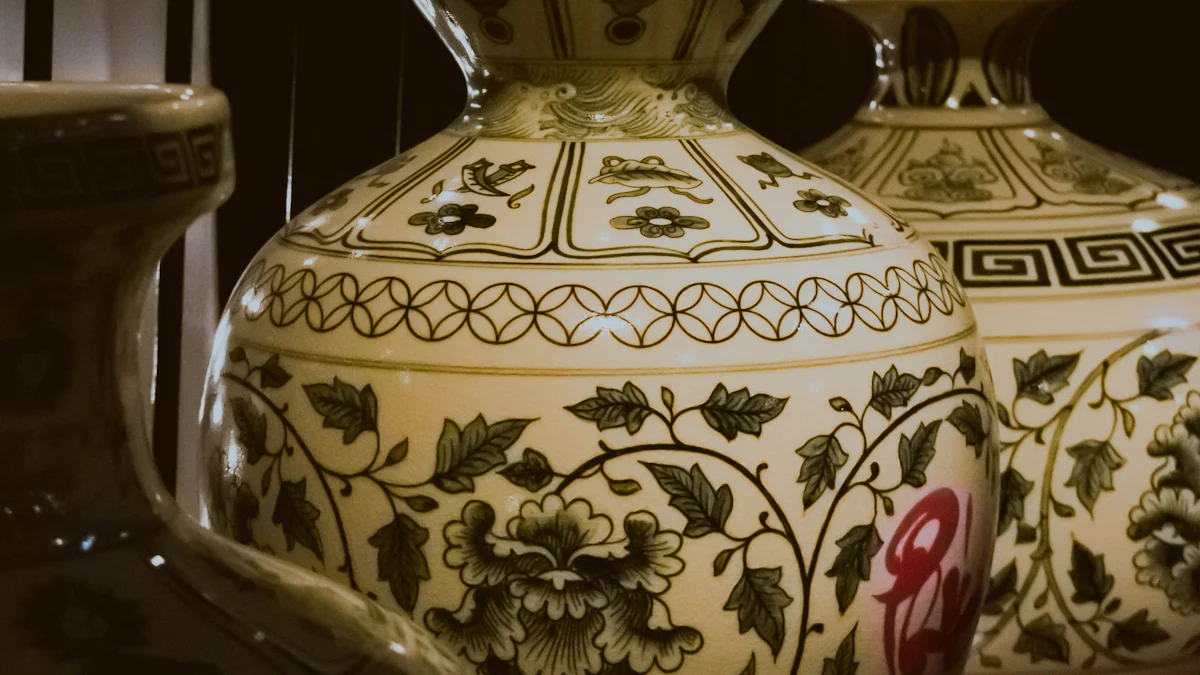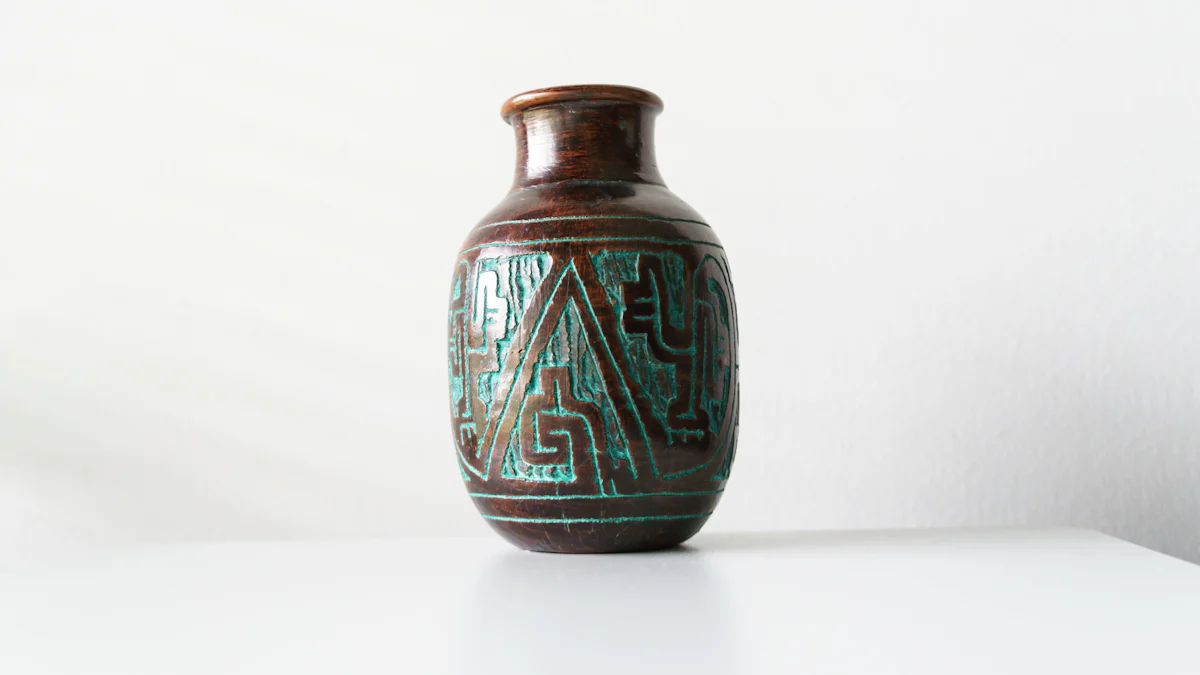
Identifying authentic antique vases holds immense importance for collectors and enthusiasts. Old style vases possess unique characteristics that set them apart from modern replicas. The value of old style vases continues to rise, with European imports growing from €3.4 billion in 2018 to €4.6 billion in 2022. These vases represented 58% of worldwide imports in 2022. Each old style vase tells a story, reflecting the artistry and craftsmanship of its time. Understanding the significance of old style vases allows you to appreciate their historical and cultural value. Recognizing genuine pieces ensures that you invest wisely in these timeless treasures.
Understanding Materials
Porcelain
Characteristics of porcelain
Porcelain stands out as a refined material in the world of old style vases. The texture of porcelain feels smooth and delicate to the touch. Porcelain often exhibits a translucent quality when held up to light. This feature adds an ethereal beauty to the vase. The weight of porcelain tends to be lighter compared to other materials. This characteristic makes it easier to handle and display.
How porcelain aids in identification
Porcelain helps in identifying old style vases by revealing clues about their origin. The mineral impurities present in porcelain can indicate the time period of production. Experts use advanced techniques to analyze these impurities. This analysis provides a more accurate window of time for the vase’s creation. The translucency and texture of porcelain also offer insights into its authenticity.
Ceramic
Characteristics of ceramic
Ceramic vases possess a robust and earthy feel. The surface of ceramic often appears matte or slightly textured. This texture gives ceramic vases a rustic charm. The weight of ceramic is usually heavier than porcelain. This heaviness adds to the stability of the vase when displayed. Ceramic vases often showcase vibrant glazes that enhance their visual appeal.
How ceramic aids in identification
Ceramic materials aid in identifying old style vases through their unique palettes and glazes. Antique Asian ceramics from the Kangxi Dynasty exhibit shiny underglazes. Mid-century modern ceramics feature more muted palettes. These distinct characteristics help determine the era of the vase. The texture and weight of ceramic also provide clues about its authenticity.
Glass
Characteristics of glass
Glass vases captivate with their clarity and brilliance. The surface of glass feels smooth and cool to the touch. Glass vases often display intricate patterns and designs. These designs add an artistic flair to the vase. The weight of glass varies depending on its composition. Some antique glass vases, like carnival glass, are heavier due to metallic coatings.
How glass aids in identification
Glass materials assist in identifying old style vases through their composition. The thickness and weight of glass can indicate its age and origin. Carnival glass vases, for example, have a distinct metallic paint coating. This coating makes them heavier and thicker than plain glass vases. The clarity and design of the glass also offer insights into its authenticity.
Examining Physical Characteristics

Hand-blown Features
Hand-blown features distinguish many old style vases from modern replicas. Artisans create these vases by manually shaping the glass, resulting in unique characteristics. You can identify hand-blown vases by looking for slight variations in shape and size. These imperfections indicate the vase’s handcrafted nature. The presence of air bubbles within the glass also suggests a hand-blown origin. These bubbles form during the blowing process and add to the vase’s authenticity.
The significance of hand-blown features lies in their historical value. Hand-blown old style vases often date back to periods when artisans crafted each piece individually. This method reflects the skill and dedication of the craftsman. Collectors value these vases for their uniqueness and connection to the past. Understanding hand-blown features helps you appreciate the artistry involved in creating these timeless pieces.
Polished Edges
Polished edges serve as another indicator of authenticity in old style vases. Artisans achieve polished edges by carefully smoothing the glass after blowing. This process results in edges that feel smooth and shiny to the touch. You can identify polished edges by running your fingers along the rim or base of the vase. The smoothness indicates the extra care taken during production.
The significance of polished edges extends to the vase’s overall quality. Polished edges suggest that the vase underwent meticulous finishing. This attention to detail enhances the vase’s aesthetic appeal and durability. Collectors often seek old style vases with polished edges for their superior craftsmanship. Recognizing polished edges allows you to differentiate between genuine antiques and modern imitations.
Maker’s Marks
Maker’s marks provide valuable information about old style vases. These marks often appear on the bottom or lower part of the vase. You can find maker’s marks in various forms, such as stamps, signatures, or engravings. Each type of mark offers clues about the vase’s origin. Some marks include the name of the artisan or company that produced the vase. Others may indicate the place of production or the time period.
Interpreting maker’s marks requires knowledge of historical context. Overmarks, for example, reveal vases made between 1880 and 1930. These marks sometimes indicate European imports. Understanding maker’s marks helps you trace the vase’s history and authenticity. Collectors rely on these marks to verify the provenance of old style vases. Recognizing and interpreting maker’s marks enhances your ability to spot genuine antiques.
Historical Context
Time Period
Antique vases often reflect the time period in which artisans crafted them. The features of old style vases provide clues about their era. For example, Chinese vases from the Song era exhibit simple designs and muted colors. The Ming era introduced vibrant glazes and intricate patterns. Each era left a distinct mark on the vases produced during that time.
Inferring the time period from vase features involves examining style and materials. Old style vases from different eras showcase unique characteristics. Artisans in ancient times used specific techniques and materials. These elements help determine the age of a vase. Collectors can identify the era by studying these features closely.
The importance of the time period in authenticity cannot be overstated. Knowing the era helps verify the vase’s origin and value. Old style vases from certain periods hold more historical significance. Collectors seek these vases for their cultural and artistic value. Understanding the time period enhances appreciation and ensures wise investments.
Place of Production
The place of production plays a crucial role in identifying old style vases. Different regions have distinct styles and techniques. Chinese vases, for instance, often reflect the cultural influences of their origin. Vases from Europe might display different artistic elements.
Inferring the place of production involves analyzing design and craftsmanship. Old style vases from Asia might feature traditional motifs and symbols. European vases often showcase elaborate decorations and forms. The materials used also provide hints about the region. Clay and glaze types vary across different areas.
The importance of the place of production lies in its impact on authenticity. Knowing where a vase was made helps determine its historical context. Old style vases from renowned regions carry more prestige. Collectors value these vases for their provenance and artistry. Recognizing the place of production aids in distinguishing genuine antiques.
Consulting Experts and Resources
Expert Consultation
How to find and consult experts
Finding experts in the field of old style vases can greatly enhance your understanding. Start by researching museums and galleries that specialize in antique ceramics. Many institutions host lectures or workshops led by specialists. Stacey Pierson, an expert in Chinese porcelain, often shares insights during museum visits. Attending such events provides opportunities to learn directly from knowledgeable individuals. You can also reach out to universities with art history departments. Professors and researchers may offer valuable guidance on identifying authentic pieces.
Benefits of expert consultation
Consulting experts offers numerous advantages. Specialists possess extensive knowledge about old style vases. They can identify subtle features that indicate authenticity. Experts like Maureen Warren, a curator, analyze colors and brush strokes to determine a vase’s origin. This expertise helps you make informed decisions when purchasing or appraising vases. Expert consultation also provides access to a network of collectors and enthusiasts. Building connections within this community enhances your ability to spot genuine antiques.
Using Resources
Recommended resources for verification
Utilizing reliable resources is essential for verifying old style vases. Books and catalogs on antique ceramics serve as excellent references. Look for publications authored by recognized experts in the field. Online databases and auction house archives offer additional information. These platforms often feature detailed descriptions and images of authentic vases. Museums and libraries provide access to historical records and documentation. Visiting these institutions allows you to study authentic pieces firsthand.
How to effectively use resources
Effectively using resources requires a strategic approach. Begin by gathering information from multiple sources. Compare details such as maker’s marks, materials, and design features. Cross-referencing data helps confirm the authenticity of old style vases. Take notes and organize findings systematically. This practice aids in building a comprehensive understanding of antique vases. Engaging with online forums and discussion groups can also be beneficial. Interacting with fellow collectors provides additional insights and perspectives.
Understanding the key points of identifying authentic antique vases enhances your ability to recognize genuine pieces. You can practice these skills by examining vases in local thrift stores or antique shops. A DC woman discovered an authentic Mayan vase in a thrift store, proving the value of keen observation. Authentic antique vases hold immense historical and cultural significance. Recognizing their value allows you to appreciate the artistry and craftsmanship of past eras. Embrace the journey of discovering these timeless treasures.

